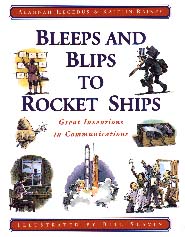| ________________CM
. . . . Volume VIII Number 2 . . . . September 21, 2001

 |
Bleeps and Blips to Rocket Ships: Great Inventions in Communications.
Alannah Hegedus & Kaitlin Rainey. Illustrated by Bill Slavin.
Toronto, ON: Tundra, 2001.
88 pp., pbk., $19.99.
ISBN 0-88776-452-5.
Subject Headings:
Inventions-Canada-History-Juvenile literature.
Communication-Canada-History-Juvenile literature.
Inventors-Canada-History-Juvenile literature.
Grades 5-9 / Ages 10-14.
Review by Gail Hamilton.
*** /4 |

excerpt:
Radio dramas required convincing sound effects, and soon radio stations were full of a
whole assortment of junk used for creating just the right smash, crash, creak or rumble. Some
things were built specially, like door frames that could vary the pitch of a slammed door. Coconut
shells were "walked' across gravel to sound like horses, steel sheets were wobbled to make
thunder, and cornstarch boxes were squeezed to sound like someone walking through snow. As
microphones and amplifiers improved, different techniques were needed to create a realistic sound
effect. Eventually, whole libraries of sounds were recorded and sold to radio stations around the
world.

The work of ten creative and talented Canadian inventors is showcased in this detailed,
informative book. Ten chapters cover a wide variety of communication-related topics, beginning
with the invention of newsprint and including the halftone photograph, panoramic camera,
transatlantic phone cable, telephone, radio wirephoto, satellite and fibre optics. These marvels of
communication had a profound impact on the way people all over the world send messages and
were the frontrunners for cellular phones and TV transmissions via satellite.

The authors have done thorough research into the inventors and their creations. By employing
fact boxes, little-known trivia and a fairly simple writing style which helps readers to see the
inventors as human beings rather than mere scientists, the authors deliberately set out to sustain
readers' interests. For example, William Stephenson, aka Intrepid, one of the greatest spies of the
20th century, was a good friend of Ian Fleming, author of the "James Bond" novels. Fleming used
some of Stephenson's real-life experiences as the basis for Bond's adventures and frequently
consulted Stephenson about the spy gadgets that Bond uses in the books.
For the science and/or science fair buff, there are instructions on how to make paper, create a
halftone image, build a pinhole camera, wire a telegraph, use Morse code and make a light
fountain, all with simple inexpensive materials that are readily available. There is a great deal of
text in this book (almost too much info) but it is offset by the mixed media (inkline and
watercolor) sketches. A glossary and an index are also provided. Despite its being a very good
resource for students doing research on communication or Canadian inventors, this book has a
fairly limited audience.
Recommended.
Gail Hamilton is a teacher-librarian at Bird's Hill School in East St. Paul, MB.

To comment
on this title or this review, send mail to cm@umanitoba.ca.
Copyright
© the Manitoba Library Association. Reproduction for personal use
is permitted only if this copyright notice is maintained. Any other reproduction
is prohibited without permission.
Published
by
The Manitoba
Library Association
ISSN
1201-9364
NEXT REVIEW | TABLE OF CONTENTS FOR THIS ISSUE - September
21, 2001.
AUTHORS
| TITLES | MEDIA
REVIEWS | PROFILES | BACK
ISSUES | SEARCH | ORDER
| CMARCHIVE | HOME |

